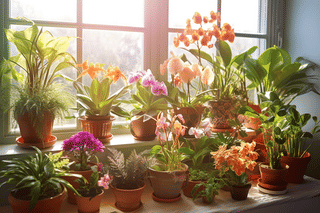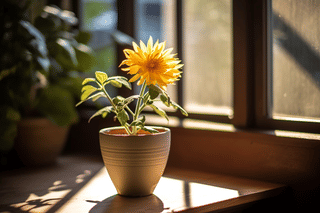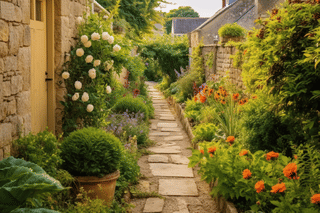How to Make Indoor and Outdoor Flowers Last Longer
Learn how to make your indoor and outdoor flowers thrive with this comprehensive plant care guide. Discover simple yet effective tips to extend the lifespan of your flowers. Let's help your plants flourish for longer with expert advice and unleash your green thumb!
Are you a flower enthusiast looking for ways to make your flowers last longer? You've come to the right place! No one likes wilting and drying flowers, so what can you do to make them look like the beautiful flowers you know they are for longer? That's exactly what we're going to find out in this plant care guide!
In this comprehensive plant care guide, we will look at practical tips and techniques that will help you extend the life of your indoor and outdoor flowers. These tips will help you to keep your house and garden looking colorful for longer.
These are the topics we're going to look at together in this plant care guide:
Are you ready to start learning how to extend the life of your flowers? Let's dive in!
Why do flowers only look great for a short time?
To understand how we can help our flowers for longer, it's important to learn why they only look great for such a short time.
Flowers are living organisms just like us. They need food, water, and sunlight to survive and this is why they don't last forever. When the soil dries out or when the flowers don't get enough light or nutrients, they will start to wilt and die.
A great example of this is the flowers of a cactus in the desert. These flowers will only last for a day because the desert is very hot and dry. The flowers will simply dry out and die.
Another reason flowers don't last very long is because they have a specific function for the plant it's connected to: attract insects to pollinate the plant.
So, depending on the species of plant and how adapted it is to its environment, flowers will usually only last for a few days or weeks.
But we can do something about that! We can extend its life by taking a few simple steps.
Making indoor flowers last longer
It might seem difficult, but extending the life of your indoor flowers is possible with a few simple techniques. Indoor flowers are more controllable in terms of the environment, but they need special attention because they need us to fulfill their needs. Let's explore how you can make your indoor blossoms thrive longer, adding vibrant colors and fresh fragrances to your home.
Light and water requirements
Proper light and water are crucial for your indoor flowers' health. Place your flowers where they can get indirect sunlight for at least 6 hours a day. As for watering, the frequency depends on the type of flower. Generally, watering once a week is sufficient. Overwatering can be harmful, so always check the soil's moisture level before watering.
Florists use a special trick to keep their flowers looking fresh for longer. They keep their flowers in dark spaces and keep them well-hydrated. By keeping your flowers in a darker space, it dries out less quickly and takes a little less effort from you to keep it growing in moist soil.
Proper temperature
Maintaining a constant temperature is essential for extending the lifespan of your flowers. Sudden temperature variations can stress the plant and lead to wilting or even death.
Indoor flowers thrive at room temperature, between 18 - 24℃ (65 - 75 ℉). By keeping your flowers within this temperature range, you can help them live longer, promoting healthier growth and more vibrant blooms.
A stable environment allows the plant's metabolic processes, like photosynthesis and nutrient uptake, to continue like normal, which improves the overall plant health and helps it to last longer.
Avoid placing your flowers near windows with fluctuating temperatures, or in areas exposed to drafts. Even moving your flowers from one room to another can cause a shock to their system if the temperature difference is quite large.
Pruning and fertilizing techniques
Pruning and fertilizing are crucial components that can extend the life of your indoor flowers quite a bit. Pruning involves removing dead or dying parts of the plant, allowing it to redirect its energy toward new growth. Regularly inspect your flowers and remove any withered leaves or blooms. Make sure to use clean, sharp shears to prevent the spread of plant diseases.
Fertilizing, on the other hand, is all about supplying your flowers with the nutrients they need to flourish. Most flowers need a balanced fertilizer that supplies nitrogen, phosphorus, and potassium in adequate amounts.
Indoor flowers generally benefit from a lower-strength fertilizer applied more frequently, usually once every 14 days to once per month. Keep in mind that over-fertilization is bad for your flower, causing more harm than good. So make sure to always follow the instructions on the label of your fertilizer.
Making outdoor flowers last longer
Outdoor flowers have to deal with a lot of weather: sun, wind, rain, and fluctuating temperatures and they still manage to brighten our gardens with vibrant colors and amazing scents.
However, they can do so much more if we invest a little time and effort into their care. Just like indoor flowers, there are ways to extend the lifespan of outdoor flowers and enjoy their beauty for longer. So, let's begin our journey toward a garden full of lively, long-lasting flowers!
Light and water requirements
Just as with indoor flowers, light, and water play critical roles in the health of outdoor flowers. Most flowering plants prefer full sunlight, which means at least six hours of direct sunlight each day. However, there are also flower species that do well in partial shade, so it's important to understand the specific needs of your plants.
As for watering, it's usually recommended to water outdoor plants early in the morning, allowing the water to soak deep into the soil before the heat of the day evaporates it. The amount of water needed depends on the type of flower, the soil, and the climate. However, as a general rule, a deep watering once a week should suffice for most outdoor flowers.
Proper temperature
Outdoor flowers also require a stable temperature to stay healthy, just like indoor flowers. In winter, when temperatures drop below 0 ℃ (32℉), some species of outdoor flowers may need extra protection from the cold. You can use mulch or protective coverings such as burlap or horticultural fleece to insulate them against cold temperatures.
However, most flowers will die during this time of year and start growing again in the spring. This is their natural yearly cycle, so don't try to change anything for these types of plants.
In summer, when temperatures can be very hot and dry, some plants may need to be watered more often to keep them hydrated. Keeping an eye on the weather forecast and preparing your flowers in advance for extreme temperature variations can help them last longer and thrive better.
Outdoor flowers are generally hardier, but extreme temperatures can still harm them. Provide shade during hot summer days and consider mulching to regulate soil temperature.
Pruning and fertilizing techniques
Pruning outdoor flowers is an effective way to extend their lifespan. Regular pruning also encourages bushier growth and more blooms. It's best to prune in late winter or early spring when the plants are dormant. Always use clean, sharp tools to avoid damaging the plant or introducing disease.
Fertilizing outdoor flowers provides them with the essential nutrients they need to flourish. A well-balanced fertilizer that contains even levels of nitrogen, phosphorus, and potassium is ideal for most flowers.
Nitrogen promotes leaf growth, phosphorus supports root development and flowering, and potassium increases the plant's overall health and resistance to diseases. It's typically best to fertilize your flowers in the spring when growth is most active and repeat throughout the growing season according to the instructions on the fertilizer package.
Can deadheading flowers make them bloom again?
We've already looked at pruning dead or dying parts of the plant to help encourage new growth. But can you cut off the dead flower to make the plant grow a new flower to enjoy? Let's find out!
Deadheading is the process of cutting off dead flowers to encourage new growth and blooming. This practice encourages some species of plants to produce more flowers, while others may not respond at all or just produce a few extra blooms.
It's important to keep in mind that deadheading requires removing the entire flower bud, including the stem and sepals. Simply pinching off the petals won't do much to encourage new growth.
Examples of flowers that bloom again after deadheading
These are a few flowers that will likely bloom again when you deadhead them:
- Roses: Roses respond well to deadheading, which stimulates a new flush of blooms.
- Geraniums: Deadheading dead blooms encourages geraniums to produce more vibrant clusters of flowers.
- Marigolds: Deadheading marigolds can significantly increase their blooming time, filling your garden with colorful, aromatic flowers.
- Petunias: Regular deadheading can keep petunias blooming all summer long.
- Dahlias: Deadheading not only encourages dahlias to create more blooms, but it also helps maintain their vigorous growth.
- Zinnias: These bright and cheerful flowers will reward your deadheading efforts with a continuous supply of new blooms.
- Echinacea: Deadheading encourages these tough perennials to develop more flowers and extends their blooming season.
- Salvias: Deadheading salvias can stimulate a second wave of blooming, providing beautiful color in your garden.
- Cosmos: Deadheading cosmos can trigger them to produce more flowers well into fall.
- Snapdragons: Regularly deadheading the spent flowers of snapdragons encourages the plant to produce more blooms.
Thank you for reading this post! I hope it helps you to keep your plants healthy and beautiful! If you're looking for more guides on specific plants, you can always request a plant guide to get a guide for the plant you have trouble with.
Test your plant care knowledge
Quiz completed!
Want to learn more? Sign up for my newsletter to receive free tips in your inbox!
Sign up now!











